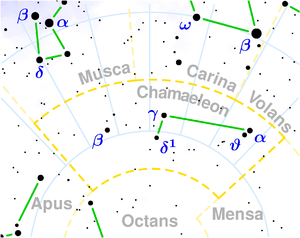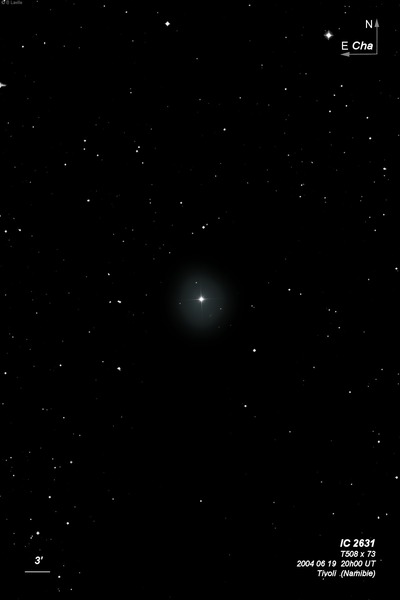 A tiny constellation near the south celestial pole forming an inconspicuous irregular rhombus of stars of apparent brightness 4mag and 5mag south of the flying fish, the Centaurus and the Musca. Its defining stars are α, β, γ and δ Chamaeleontis. Chameleon is, as in nature, inconspicuous in the sky: it disappears in a region poor in brighter stars around the south celestial pole. All the stars of Chameleon are faint, and the constellation is one of the smallest and most difficult to identify. It is only revealed by the longer arm of the Southern Cross pointing at it from the north. The constellation is not visible to us.
A tiny constellation near the south celestial pole forming an inconspicuous irregular rhombus of stars of apparent brightness 4mag and 5mag south of the flying fish, the Centaurus and the Musca. Its defining stars are α, β, γ and δ Chamaeleontis. Chameleon is, as in nature, inconspicuous in the sky: it disappears in a region poor in brighter stars around the south celestial pole. All the stars of Chameleon are faint, and the constellation is one of the smallest and most difficult to identify. It is only revealed by the longer arm of the Southern Cross pointing at it from the north. The constellation is not visible to us.
α Cha - The brightest star of the constellation. It has an apparent magnitude of only 4.08. This white dwarf of spectral class F5 is located 64 light-years away from us.
θ Cha - Optical binary star, whose components appear very close to each other in the sky from Earth, but are actually very far apart in space. The brighter component with a magnitude of 4.3 is located at a distance of 100 light years, while the fainter one is separated from us by up to 1,000 light years.
δ Cha - A wide double star, whose components have magnitudes of 4.4 and 5.5, are separated by 7 arc minutes, so they can be resolved with the naked eye. In a telescope, we can observe their distinct white and orange hues. It is an optical double star: the brighter component is located at a distance of 364 light-years, while the fainter one is 10 light-years closer. However, the brighter component is actually a very close physical double star, which can only be resolved with a large telescope.
Z Cha - A weaker variable star, which shines only as a 16.2 magnitude star at its minimum, so it can only be seen in a large telescope. However, every three to four months, it suddenly brightens and within a few hours its brightness increases to 11.5 magnitude. For several days, it can then be seen even in a 150 mm telescope.
NGC 3195

John Herschel discovered NGC 3195 = h3241 on 24 Feb 1835 and recorded "planetary nebula, pB, not quite uniform in its light, having two brighter patches, lE towards a * (a); slightly hazy; diameter = 15 or 18" (in RA 13 seconds of time). Pos of star a = 265.7 , dist = 0.7 diam from edge, 11th mag.; of star c, pos = 210.7 , dist = 1 3/4 diam from edge." On a later sweep he described "Planetary nebula, R or vlE; a very little hazy at the edges but still pretty well defined with 240 power. Viewed long and with much attention, being a very remarkable object. I am positive of the existence of two brighter portions near the edges." Sketched Plate VI, figure 2.
Joseph Turner sketched the planetary in July 1874 using the Great Melbourne Telescope (unpublished Plate V, figure 54). His sketch shows it clearly as annular with brighter arcs on the east and west side. Pietro Baracchi (10 Apr 1885) thought the annular rim was slightly brighter on the E and W sides.
400/500mm - 18" (7/8/02 - Magellan Observatory, Australia): this is an interesting planetary at 171x with a UHC filter or at 228x. It appeared moderately bright and large, ~40"x35", slightly elongated ~N-S. This disc had a noticeably irregular surface brightness with a slightly brighter knot on the following side and a hint of annularity. Good response to UHC and OIII filters. Located in southern Chamaeleon between Zeta and Delta Chamaeleontis.
600/800mm - 24" (4/4/08 - Magellan Observatory, Australia): at 350x, appeared fairly bright, moderately large, slightly elongated SSW-NNE, ~40"x35". The planetary was clearly annular at this magnification with the rim brightest along the east and west sides, giving a bipolar appearance. The southern end of the rim dimmed, making the rim appear U-shaped, open to the south (though also somewhat weaker on the north end). The central hole was irregularly shaped with careful examination. Two mag 12 stars to the west at 45" and 1.6' are collinear with the planetary and a brighter mag 11.5 lies 2' SE. The surrounding field was lacking in bright stars but rich in faint stars. NGC 3149 lies 30' NNW.
Notes by Steve Gottlieb
IC 2631

Several star fields to the south of IC 2631 were strangely devoid of stars due to the huge molecular Chamaeleon Dark Cloud. Only a few brighter stars were visible in the 30' field at 200x (13mm Ethos). The center is roughly 40' S of IC 2631 and the dark cloud appears elongated 2:1, roughly 90'x45' N-S.
The Chamaeleon dark cloud complex is a complicated structure consisting of 3 large molecular clouds (designated Cha I, II, III by Hoffmeister 1963) and a number of smaller clumps and globules. The region I observed corresponds with Cha I and contains the reflection nebula Ced 110 = GN 11.04.8 and Ced 111 (surrrounding T Tauri stars HD 97048 = CU Cha and DI Cha).
DeLisle Stewart discovered IC 2631 = D.S. 352 on a plate taken on 22 May 1900 at Harvard's Arequipa Station. He noted "* 9 involved in neb of 2' radius."
600/800mm - 24" (4/11/08 - Magellan Observatory, Australia): surprisingly bright, very large reflection nebula surrounding the mag 9.0 pre-main-sequence star HD 97300 (Herbig Ae/Be dwarf). The nebula extended nearly 8' in diameter (fading out around the edges) and appeared essentially round. It was missed by John Herschel although he picked up NGC 3620, a faint galaxy 32' NE. IC 2631 is not plotted in Tirion's Sky Atlas 2000, Uranometria 2000 (both 1st and 2nd editions), nor the Millennium Star Atlas.
Notes by Steve Gottlieb